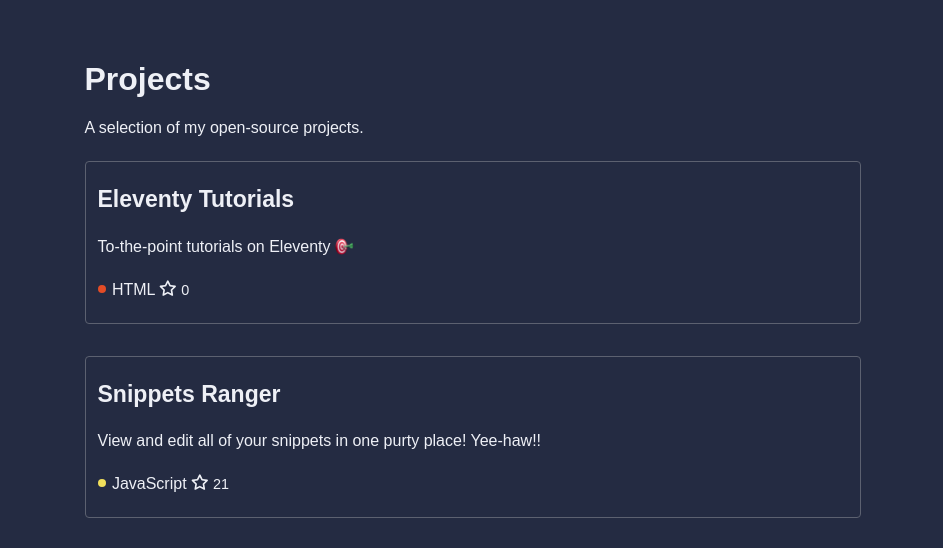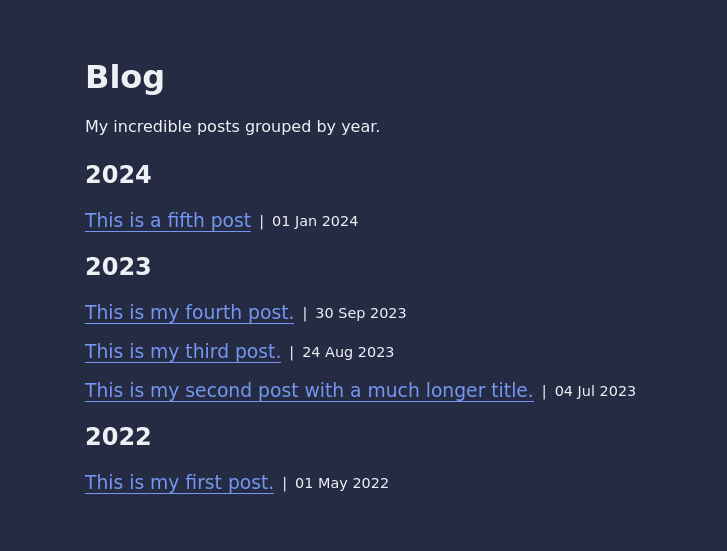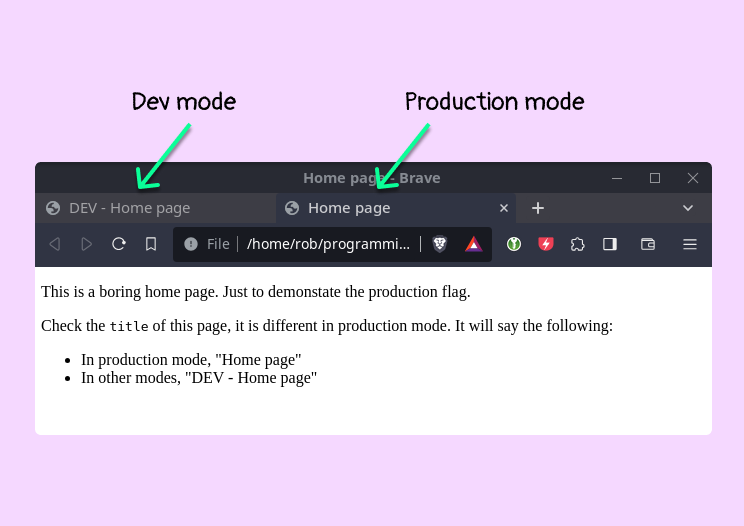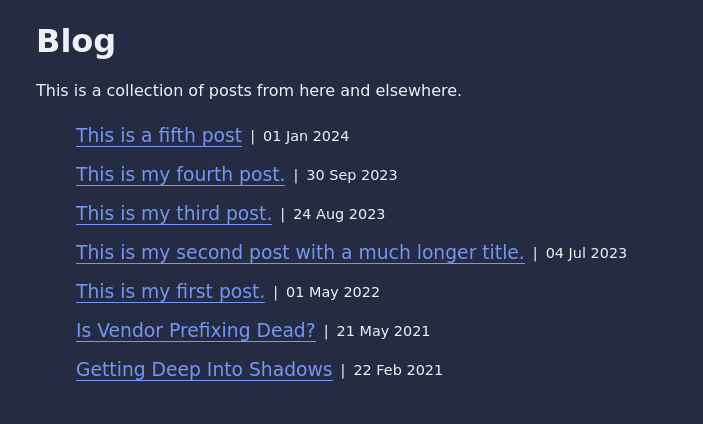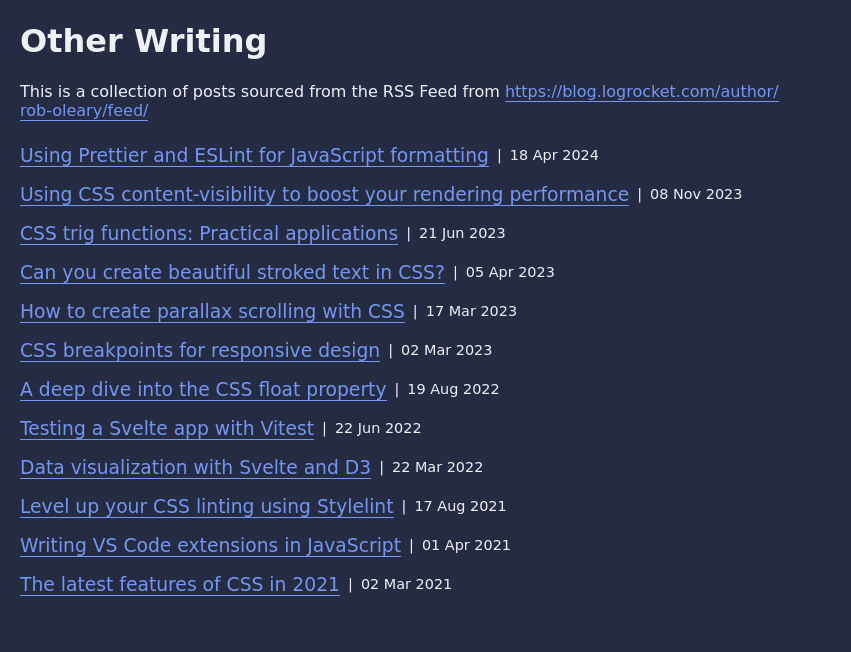Tutorials on the Eleventy static site generator.
Each tutorial is a self-contained eleventy project.
I use eleventy's default settings most of the time for simplicity. The default project folder looks like this:
default-elventy-project/
|- _data/ <- global data files
|
|- _includes/ <- includes and layouts
|
|- _site/ <- the output folder for the generated website
|
|- eleventy.config.js <- eleventy config file
The one exception is that I use nunjucks templating instead of Liquid because it is more popular, and has more a few powerful features.
If I stray from these conventions, I will mention in the tutorial.
Open one of the tutorial subfolders. Then, run npm install (or equivalent for your favourite package manager) to install the dependencies. Then, you can run the website locally with npm run dev.
Tutorial List
- GitHub projects
- Group posts by year
- Favicon to differentiate between dev and production build modes
- Production flag
- Merge custom data with a collection (Make a writing archive)
- Convert a RSS Feed into a collection (Make a writing archive)
- CSV data file (Make a "currently reading" bookshelf)
A projects page that is populated with data fetched from the GitHub API.
We provide a list of repositories that we want to feature in _data/projects.json in the following format:
[
{
"title": "Eleventy Tutorials",
"repository": "https://github.com/robole/eleventy-tutorials"
},
{
"title": "Snippets Ranger",
"repository": "https://github.com/robole/vscode-snippets-ranger"
}
]We use the GitHub API to provide the additional fields: description, language, and star count.
You can read this tutorial for a walkthrough.
The project is in the github-projects folder.
It is popular to group posts by year for a blog or archive. I will show you how to do this in ascending or descending order.
The project is in the group-posts-by-year folder.
Show a different favicon if the project is run in dev mode or production mode. This gives a clear visual indicator of what version of your website you are seeing in the browser.
You can read this tutorial for a walkthrough.
The project is in the favicon-dev folder.
A production flag is useful for activites that you only want to happen in production such as minifying assets. This project adds a production variable that can be used everywhere.
The demo changes the title of the homepage if it is run in dev mode or production mode.
You can read this tutorial for a walkthrough.
The project is in the production-flag folder.
Perhaps you post on other websites and would like to reference those external posts on your blog. For example, I wrote a couple of articles on CSS Tricks and would like to include them in my blog for posterity. Rather than make a markdown file for each external post, you could just create a JSON data file and merge it with your posts collections.
This is the _data/externalPosts.json file:
[
{
"url": "https://css-tricks.com/is-vendor-prefixing-dead/",
"date": "2021-05-21T00:00:00Z",
"data": {
"title": "Is Vendor Prefixing Dead?",
"description": "Browser vendors slowly began to move away from prefixing in 2012. It appeared that the problems created by vendor prefixes would fade away in time. The question is: has that time come yet?",
"image": "/assets/img/external-posts/2021-05-21-prefixing-dead.webp",
"publisher": "CSS Tricks",
"tags": ["CSS"]
}
}
]My CSS Tricks posts gets added to my blog list as below.
The project can be found in the external-posts folder.
Here I demonstrate how to fetch a RSS feed with eleventy fetch, and parse the feed to use as a collection.
In this instance, I am creating a collection from the articles I wrote for LogRocket. LogRocket creates a RSS feed for each author. I list the LogRocket articles on the "Other Writing" page, as per screenshot below.
The project can be found in the rss-feed-to-collection folder.
Here I demonstrate how to add the CSV file type as a data file.
In this example, I am displaying my "currently reading" bookshelf. I exported the data as a CSV from the Calibre e-book library app that I use to manage my library.
The project can be found in the csv folder.

